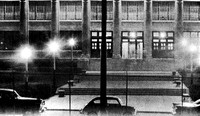A half-century ago, 458 seniors pulled off their robes after commencement ceremonies at Tucson High School and said good-bye. Some were in tears, others in jubilation. Some would marry a classmate or otherwise keep regularly in touch; others would never see each other again.
Born in 1943, '44 or '45, when Tucson was a sleepy town of under 40,000, the class of 1962 had come from Tucson's richest and poorest neighborhoods. They had witnessed the birth of home television, heard the blaring of air raid sirens during Cold War drills and rocked and rolled to "American Bandstand." Now, they would move on: Some to the University of Arizona or other colleges; others to jobs or married life. Some would find success in their personal and professional lives; others would stumble or would die early of accident or illness.
As a microcosm of Tucson, circa 1962, they symbolize men and women who have always made contributions to their communities.
Augustine (Augie) Gallego became chancellor of San Diego Community College District. John Klensin made key contributions to development of the Internet and was inducted into the Internet Society's Hall of Fame. Peggy Scanlon Cabaniss heads a financial planning and investment advisory firm. Tom Kalinske, former CEO of Mattel Inc., Matchbox Toys, Sega of America and LeapFrog Toys, is chairman of Cambium Learning Group and Global Education Learning. Victor Marmion served as Nogales police chief. Mike Butler, a combat pilot during Vietnam, retired as a Marine colonel. Jay Caldwell is in the University of Alaska Athletic Hall of Fame for his work as team physician. Architect Rich Bierce has guided preservation of historic buildings in the Washington, D.C. area.
Many others have also made their marks. They include Mack Wilbourn, who operates several restaurants and was a key Atlanta supporter of President Obama's re-election campaign. Don Bacon coaches at Sahuaro High. Herb Craig has been on the leading edge of several tech enterprises and is design manager for super-computer software. Mike Jacobs has operated a family mineral-testing firm, believed to be Tucson's oldest business. Charles Blitzer was a senior staff member at the World Bank and International Monetary Fund. Barbara Camacho Benton, Cecilia Martinez Estrada and other women became distinguished teachers and principals at a time when gender bias discouraged women's entry into other fields. Beth Omansky, who lost much of her vision after high school, wrote a book demystifying the concept of "legal blindness."
I'm proud of these men and women. They were my classmates, brought together in Tucson's oldest high school in a demographic rainbow. We were poor, middle class and rich; white, black, Asian, Mexican American and Native American. Things were far from perfect. Some teachers and counselors held low expectations of blacks and Mexican Americans and tended to track them into vocational courses. Teenage jealousies and angst ruined many relationships.
Yet, most of us got along well, developing lifelong connections and respect for multiculturalism. (In the 1980s, the school was designated as a magnet and was renamed Tucson High Magnet School.)
I see our achievements as a source of pride for all of Tucson. We are homegrown people who learned from parents, mentors and church leaders about work ethic and giving back to the community. Many of us credit THS teachers for jump-starting our career paths.
And a majority of class members stayed in Tucson, aiding in its development during a period of phenomenal growth. Many became community pillars as business owners, firefighters, volunteers for nonprofits, government workers and more.
Last month, 85 of us gathered for our 50th reunion. Now nearing the age of 70, many of us sported thinner hairlines and wider waistlines. We hugged, laughed, reminisced and shed tears for departed classmates. As we mingled amid oldies music at the Doubletree, I was blown away by stories of classmates' achievements. About 18 class members had earned doctorates, law degrees or medical degrees. At least 30 had become educators. Dozens had won awards.
Of course, every class has its stars, and this 1962 class is hardly unique in its accomplishments. It is impossible to say if my classmates' achievements are extraordinary or expected for such a large group of graduates.
The class member best known in 1962's media was student body president Ray Kosanke, the 6-foot-9-inch center and star of the basketball Badgers. His team, which swept through the season undefeated, capturing the state title, is regarded among the best in Arizona history. The girls' tennis team also won the state title. Kosanke went on to play at Stanford and in Europe. He later wrote for a church magazine from Europe and, upon his U.S. return, became an early proponent of renewable energy.
Did every class member find happiness and success? No. Disappointments, career failures, personal tragedies befell many of them. We've lost contact with about half of our classmates. At least 45 class members have died, including All-City basketball guards Jesse Peoples and Chester Willis. Alan Fudge died in 2011 after appearing in scores of film and TV programs, ranging from "The Natural" to "Columbo."
Although many from the class of 1962 never won public accolades, they too made solid contributions. They form part of that legion of unsung heroes in every community - people who make a difference through their work and through their family and volunteer roles.
Estrada, the former San Diego principal, reflected the thoughts of many at the reunion when she said: "My best reward was helping my students, providing them with the best education possible so that they could have a better life."
Too often, we as journalists focus on problems and the newest "crisis."
For a moment, let's recognize the THS class of 1962 as representative of other high school classes that have helped make America great.
Frank O. Sotomayor began his journalism career at THS, the UA and the Star. He was co-editor of a Los Angeles Times series on Latinos that won the 1984 Pulitzer Prize for Public Service. Contact him at frank.sotomayor@sbcglobal.net

